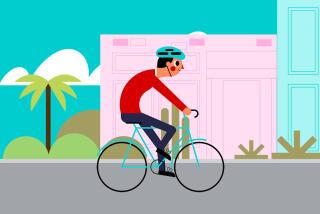Recession Hasn’t Put Brakes on Sales of Bikes, Accessories : * Marketing: Strong turnout at Anaheim trade show is evidence that sales are still in high gear. Latest innovations are displayed by more than 600 exhibitors.
- Share via
ANAHEIM — Just when it seems like city streets are bulging with bicycles, manufacturers are finding ways to sell more.
In the 1970s, teen-agers whizzed along on thin-tired racing bikes. Riders gritted their teeth and hunched over the ram-horned handlebars.
In the 1980s, bicyclists left the pavement and turned to the dirt. Mountain bikes, with knobby balloon tires and lightweight frames, were so agile that it was said they could climb tree trunks if only they had enough traction.
Now, with garages across America stacked with old racing and mountain bikes, the industry is enjoying a strong surge in sales of bikes that combine the best of both types. The hybrid or “cross” bike has the narrower tires and larger frames of the racers combined with the conventional handlebars of a mountain bike.
The hybrid is one of the hundreds of new bicycles and accessories on display today at the 10th annual Interbike International Bicycle Expo at the Anaheim Convention Center, the industry’s largest trade show.
The three-day show--closed to the public--will feature more than 600 exhibitors peddling their wares to dealers. Manufacturers will be trying to stir up interest in such innovations as puncture-proof inner tubes and carbon-fiber bicycle frames.
Promoters say this year’s strong turnout--25,000 dealers and exhibitors are expected to attend--is proof that the industry is weathering the recession. Bicycle sales in 1991 are expected to reach about 10.8 million units--about the same as last year, said Steve Ready, who is producing the show for Interbike.
“We’re pleased that in the recreation industry, the bike business is holding so stable in spite of the recession,” he said. “The fitness consciousness is very strong.”
To boost sales, manufacturers are trotting out lots of new gadgets and materials that are radically altering bicycle design.
One of the show’s hottest items are new shock absorption systems designed to cushion the ride for mountain bikers. Mountain bike sales are expected to account for 60% of all U.S. bike sales, said Mike Sinyard, president of Specialized Bicycle Components in Morgan Hill.
Though many consumers already own mountain bikes, Sinyard and other manufacturers hope that those who bought one several years ago are getting ready to trade up.
“The suspension system is a whole new technology that is coming in. The bike industry has taken to it very well,” said Chuck McCullagh, editor and publisher of Bicycling Magazine.
For aficionados, there are bikes like the RS-1 from the Gary Fisher Bicycle Co. in San Rafael, a $3,500 hunk of aluminum that cushions the rider with motorcycle-style shocks in the front and rear. Or there is the radical Allsop Softride, which has a strut that flexes like a diving board, keeping the rider stable while the bike bounces along washboard trails.
For the weekend rider, the industry is expecting the hybrids to propel sales. While hybrids have been on the market for several years, McCullagh said sales are finally taking off as casual bicyclists look for an alternative between mountain bikes and racing bikes.
Sinyard said the hybrids appeal to consumers who simply want to ride for fitness or commuting to work. “People have been buying mountain bikes for all-around use and riding them on the road,” he said. The hybrid is better-suited to the dual use.
Priced between $300 and $1,000, the hybrid can be used on streets or trails. Most are used primarily for pleasure jaunts around the neighborhood, bike makers say.
Even those old racing bikes are on the verge of a comeback. But they are returning with innovations such as lightweight carbon frames and squishy gel-filled seats.
Such features are part of a burgeoning market for bicycle accessories. Aside from the basic bike, riders usually want such items as water bottles, electronic speedometers, high-security locks and air pumps. Then there are the clothes--riding shorts, jerseys, helmets and shoes that lock into the pedals.
“By and large,” McCullagh said, “the bicycle industry is very healthy.”
Cycling by the Numbers U.S. cyclists: 33 million Median age: 35 Cost: “Enthusiasts” (those who ride frequently) spent an average of $666 for their last bike. Accidents: About 9% of all riders fall off their bikes each year. Helmets: Only 16% of all cyclists own helmets, but 68% of enthusiasts own them. Theft: About 6% of all cyclists have had their bikes stolen in the past three years; of those, 39% had locked their bikes before they were stolen. Places to ride: Neighborhood streets, 80% of all cyclists; rural roads, 26%; bike paths, 29%; bike routes, 18%. Sore point: If they had a more comfortable seat, 34% of all cyclists would ride more frequently Source: Bicycling Magazine
More to Read
Inside the business of entertainment
The Wide Shot brings you news, analysis and insights on everything from streaming wars to production — and what it all means for the future.
You may occasionally receive promotional content from the Los Angeles Times.










